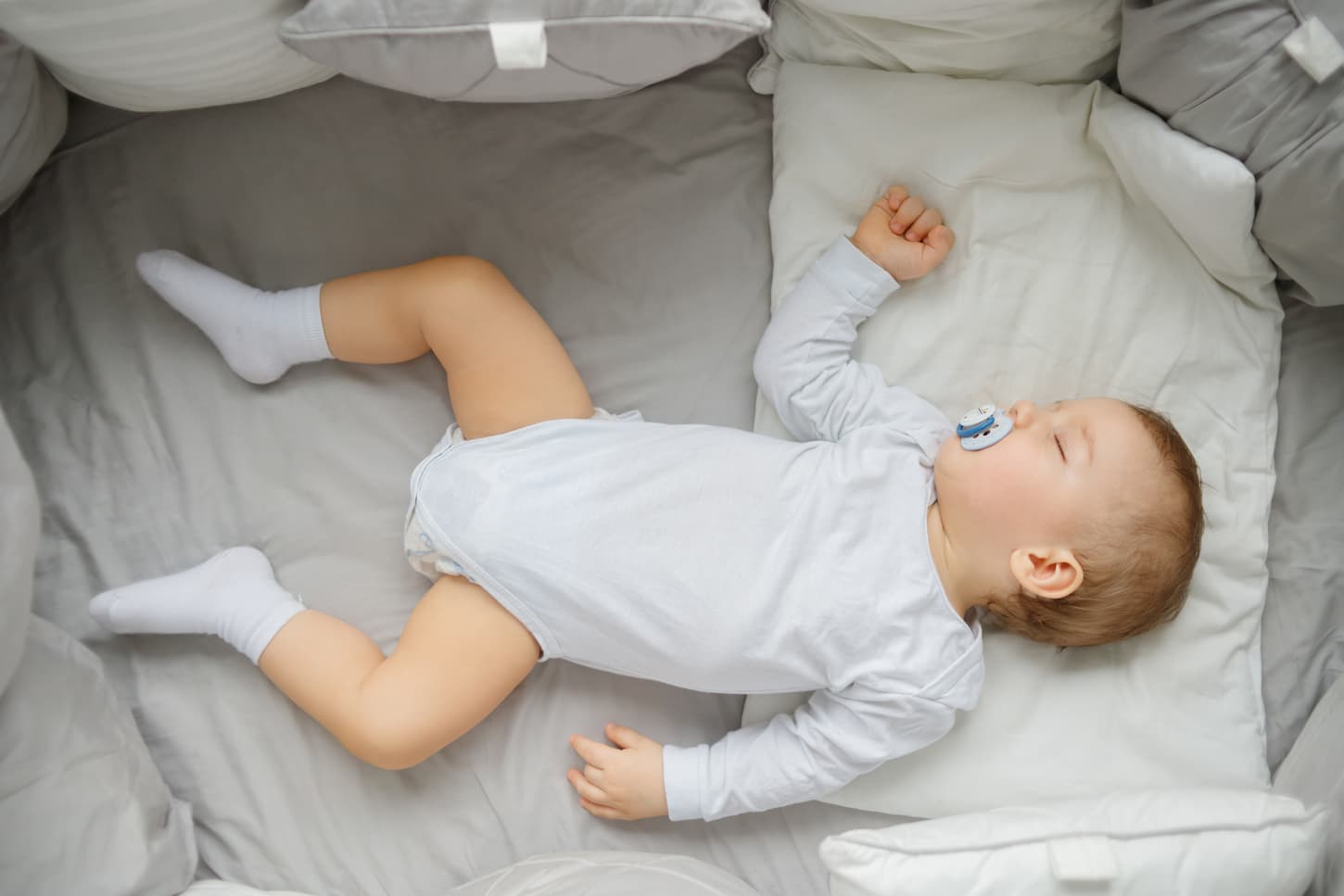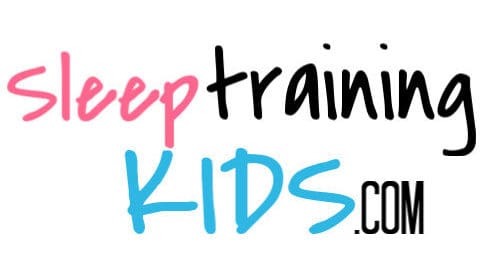As much as you love your baby, sometimes you wish she’d just go to sleep when she needs to – both at naptime and bedtime. But the truth is, your baby can sometimes prove difficult when it comes to sleep time; this makes it necessary for you to sleep train her. But, wouldn’t you want to know if sleep training your baby includes naps?
Babies need between 12-18 hours of sleep, depending on their age. Therefore, sleep training also includes naps because your baby might not get all the sleep she needs at night, making it all the more vital for her to have adequate sleep during daytime naps.
Sleep training your baby for naps works wonders – once you know what to do, anyway. So be sure to keep reading – because we’ll talk about all things sleep training for naps.

Does Sleep Training Include Naps?
Sleep training can absolutely include naps! Some babies sleep well at night but not during the day. Some babies need help settling into a daytime schedule and a nighttime sleep schedule. Other babies got the sleep schedule thing down without much help.
So if you need sleep training to include naps, then include it. Or if your baby’s fine with naps, then you can skip daytime sleep training.
Just keep in mind how many naps babies usually need. Here’s a table of usual naps by age to help you out.
| Age (months) | Number of nap sessions | Time of each nap. |
|---|---|---|
| 6 | 2 – 4 | 30 mins – 1hr 30mins |
| 9 | 1 – 3 | 30 mins- 1hr 20mins |
| 12 | 1 – 3 | 30 mins – 1hr 20mins |
| 15 | 1 – 3 | 30 mins – 1hr 20mins |
| 18 | 1 – 3 | 1hr 20mins – 1hr 30mins |
Why Do You Need to Sleep Train for Naps?
Sleep is good for adults and babies alike, which is why we all need to get adequate sleep. It even gets more important for babies to sleep well because they are still growing and developing. Babies need longer hours of sleep, and that is why they need to get enough sleep during the day and night.
Just to review, here’s how much sleep babies typically need – by age. Keep in mind that these are averages based on a lot of things. And so if your baby doesn’t fit into any of these averages, it’s not a huge problem. It just means that your baby doesn’t fit the “traditional” averages. My kids didn’t quite fit it, either.
| Age | Number of Naps | Average Nap Length | Wake Time Between Naps | Bedtime | Nighttime Sleep Requirements | Sleep Needed in 24 Hours |
|---|---|---|---|---|---|---|
| Birth to 6 weeks | 4 to 8 | 15 minutes to 4 hours | 45 minutes to an hour | Between 9 and 11 PM | 8 to 14 hours | 14 to 18 hours |
| 6 weeks to 3 months | 3 to 4 | 30 minutes to 2 hours | 1 to 2 hours | Between 8 and 11 PM | 8 to 13 hours | 11 to 15 hours |
| 3-6 months | 3 | 1 to 2 hours | about 2 hours | 8 to 10 PM | 9 to 12 hours | 12 to 16 hours |
| 6-9 months | 3 | 1 to 2 hours | 2 to 3 hours | 8 to 10 PM | 9 to 12 hours | 12 to 14 hours |
| 12-18 months | 1 to 2 | 1 to 2 hours | 3 hours | 7 to 8 PM | 10 to 12 hours | 12 to 14 hours |
| 18 months to 3 years | 1 | 1 to 2 hours | N/A | 7 to 8 PM | 10 to 12 hours | 11 to 14 hours |
| Preschoolers | 0 | N/A | N/A | 7 to 8 PM | 10 to 13 hours | 10 to 13 hours |
| Grade schoolers | 0 | N/A | N/A | 7 to 8 PM | 9 to 12 hours | 9 to 12 hours |
| Teenagers | 0 | N/A | N/A | 8 to 10 hours | 8 to 10 hours |
Here are some of the reasons for getting your child to sleep well:
- Children who get enough sleep have a stronger immune system and are usually healthier.
- They are usually happier and easier than children who don’t get enough sleep.
- Children who sleep better learn faster and have sharp memories.
As a parent, a child who sleeps well is good for your physical, emotional, and mental well-being too. Because then you can get enough sleep – and a few moments to yourself to recharge.
Can You Sleep Train at Night But Not Naps?
If your baby is sleeping well during naps and only needs help at night time, then you can most definitely only sleep train during the night. Keep in mind that your baby’s sleep habits and schedule will change as they grow. So while you may not need to use any dedicated sleep training techniques for naptimes right now, you may want to learn them anyway in the future.
In my experience as a mom, my kids did fine on naps until they were about 8 months old. That’s about when naps got crazier and we needed to reinforce good nap habits with some sleep training.

How to Sleep Train for Naps
Sleep training for naps is very similar to sleep training at night. Even so, here are the top tips and steps to sleep train for naps.
Nap Sleep Training Tip #1: Watch for Signs of Drowsiness
Look for signs of drowsiness or sleepiness. When you notice tell-tale signs that your baby is ready to take a trip to dreamland, that is your cue to put her down to sleep.
Some of the signs you should watch out for are clumsiness, crankiness, demand for attention or clinginess, and even crying.
Nap Sleep Training Tip #2: Create a Nap Schedule
Paying attention to your baby will also help you note at what time of the day he or she begins to feel drowsy. Once you notice a pattern for this, you can go ahead to prepare a nap schedule.
A nap schedule helps you get ready for that particular time of the day when your baby is ready to sleep; this enables you to set the mood right and get the environment free of anything that might want to stop your baby from falling asleep.
It’s a whole lot easier to create a nap schedule once you know when your baby usually gets tired. It’s a lot harder to force your baby to stick to a pre-set sleep schedule. That doesn’t mean you can’t do it – I know some friends and parents who managed it. It just never worked with my children. So remember that there’s always some room for individuality.
Nap Sleep Training Tip #3: Create The Right Mood
As adults, it can be quite difficult for us to get some sleep when we aren’t in the right environment or mood. To induce sleep in your baby during the day, you might want to create an environment that gives a semblance of nighttime, helping to convince the baby’s body into thinking that it’s time to sleep.
You can do this by making the environment dark and quiet, and experts suggest you use a white noise machine to block out noise.
Nap Sleep Training Tip #4: Ensure Your Baby is Comfortable and Safe
Babies react to the slightest discomfort, and if you’re trying to get your baby to nap, you have to ensure that she is as comfortable as possible.
Before you put her down, ensure she is comfortably dressed, and her diapers changed. You should also ensure she is well-fed and that there is absolutely nothing that will distract her.
Always be sure to keep the baby’s a sleeping area free from extra blankets or toys that could become suffocation hazards or risks for increased SIDS. And always put babies to sleep on their back.
Nap Sleep Training Tip #5: Get Your Baby Active When Awake
The surest and fastest way you can get your baby to nap is if she’s tired enough to want to sleep. To achieve this, you have to get her up and running when she’s awake.
Get her to play and have enough fun time with you, her toys, or her friends. It won’t take much to get her to sleep this way.
Don’t forget to take adventures outside in the sunshine, too! This will help your baby be ready for sleep at naptimes.
Nap Sleep Training Tip #6: Have a Consistent Sleep Training Method
Whatever sleep training method you decide to use on your baby, make sure you are consistent with it. Your baby needs a lot of constant practice to sleep, and it might take a while before she gets the hang of it.
If you don’t get instant results, that isn’t an indicator that you need to change your method. Instead, it’s usually a sign that they need more practice. Sometimes changing methods (especially if they’re vastly different) will confuse your baby, and you might end up not getting the result you desire.
Now, if it’s been at least a few weeks and you aren’t seeing any progress? Then it’s time to reevaluate things. It may even be time to change to a different methodology.
To read more about the various sleep training method choices, make sure you read these guides I’ve put together for parents like you.
- Behavioral Sleep Training: The Complete Guide
- Cry it Out Sleep Training: a Complete Guide with Q&A
- Baby Wake Times: a Beginner’s Guide to Wake Windows by Age
- No-Cry Sleep Training (a Complete Beginner’s Guide)
In my experience, no-cry and behavioral-based sleep training methods tend to work during naptime sleep training. That doesn’t mean cry-it-out can’t work – I know some families who did see success with it.
Nap Sleep Training Tip #7: Know What Every Cry Means
You don’t always have to rush to your baby’s side whenever she cries while sleeping. Sometimes, doing that might interrupt her nap, and you’re back to square one. Recognize when her cry means she needs your assistance and when it doesn’t.
Remember, too, that not every cry means the same thing.
My kids used to do weird one-off cries sometimes when they had a bad dream. We jokingly called it the “oh no! I’m out of milk in my dream/nightmare” scream. I learned that one fast – because if I went in to check on them during it, then my kids woke up and just wanted to comfort the nurse through nap time. And then the whole day’s naps got thrown off.
Once you have all done these, it will be easier to get your little boy or girl to sleep well during the day.
Nap Sleep Training Tip #8: Be Patient
Sleep training at night takes time. So does naptime sleep training. Give things time. You probably aren’t going to fix naps in a single day or two. And that’s okay. Because you will see slow improvement over time – and it’ll be just as awesome.

Do You Start Sleep Training With Naps or Bedtime?
It is advised that you start sleep training with bedtime rather than naps. Here are some reasons why bedtime is the best time to start sleep training:
- Bedtime is the time when the urge to sleep is usually at its highest.
- Bedtimes are easier for parents who need to sleep train.
- Getting your child prepped to fall asleep at bedtime will get her used to it, and it will make it easier to get her to sleep at naptime.
These and many more are reasons why you should start sleep training your baby at bedtime. However, you need to sleep train your baby for optimum results both at bedtime and at naps.
Babies respond well to patterns, and it’s best to work with them using patterns. Imagine trying to use a particular method to get them to sleep at one time of the day but doing none of that at another time of the day. It gets them confused, and you might not get the full benefits of sleep training them.
However, note that although you might be sleep training your baby simultaneously – at bedtime and naptime – you might begin to get faster results at bedtime than naptime.
In my experience as a mom and in talking with thousands of parents who sleep trained, you might start to notice changes in your baby’s sleep at nighttime within 3-4 days with methods like crying it out, while you may have to wait for about two weeks before you begin to see noticeable changes in her naps. Don’t let this bother you. It’s just a good average or rule of thumb to keep in mind. Every baby will have different results – and that’s to be expected.
And keep in mind that if you’re not using cry it out for nighttime sleep training, then you may not see nighttime results for a week or more.
Key Takeaways on Sleep Training
When it comes to sleep training your baby, patience is the key ingredient. This is because you might not get the results you want immediately, and this can be discouraging. It’s downright devastating when you’re sleep-deprived (been there!).
When this happens, remain patient and do what you have to do. That can mean whatever – from taking a few days off to catch up on sleep to keeping going with sleep training. It can also mean using sleep training methods you wouldn’t normally consider – like cry it out. Do what you need to to be a functional, present parent.
Remember, be consistent with your method of sleep training. Don’t be so quick to change your method if you don’t see instant results. This is another reason why you have to stay patient. If you need to change your method, I recommend that you give it at least two weeks before you change again.
It is also important for you to note that you need to keep your baby’s age in mind for sleep training. Under four months old, babies’ brains haven’t fallen into a more adult-like circadian rhythm. So they can’t be properly sleep trained. However, they can be persuaded with patterns and bedtimes to start sleeping at regular times.
If your baby is under 6 months, they can be sleep trained with some methods. I’ve got a whole article on that for you, so make sure you read that next.
Above all, have fun while sleep training your baby. Find what method works for you both and go with the flow. Sleep training your baby is all part of the “fun” experience that comes with being a parent.
And let’s end with a pro tip – because sleep training isn’t just about getting your baby to sleep. Although it does help with that. It’s also about helping you become a more confident parent – and how to parent your child effectively. So make sure that you bookmark this site for more tips. Or, if you’d like to make life easier, make sure you subscribe to our free newsletter for tips sent right to your inbox.
